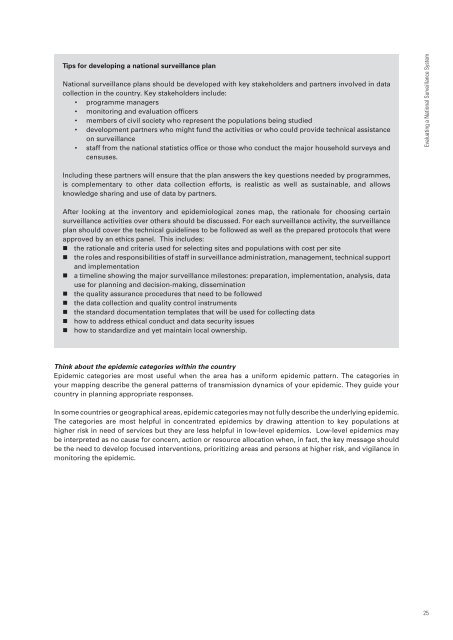Guidelines for second generation HIV surveillance - World Health ...
Guidelines for second generation HIV surveillance - World Health ...
Guidelines for second generation HIV surveillance - World Health ...
You also want an ePaper? Increase the reach of your titles
YUMPU automatically turns print PDFs into web optimized ePapers that Google loves.
Tips <strong>for</strong> developing a national <strong>surveillance</strong> plan<br />
National <strong>surveillance</strong> plans should be developed with key stakeholders and partners involved in data<br />
collection in the country. Key stakeholders include:<br />
• programme managers<br />
• monitoring and evaluation officers<br />
• members of civil society who represent the populations being studied<br />
• development partners who might fund the activities or who could provide technical assistance<br />
on <strong>surveillance</strong><br />
• staff from the national statistics office or those who conduct the major household surveys and<br />
censuses.<br />
Evaluating a National Surveillance System<br />
Including these partners will ensure that the plan answers the key questions needed by programmes,<br />
is complementary to other data collection ef<strong>for</strong>ts, is realistic as well as sustainable, and allows<br />
knowledge sharing and use of data by partners.<br />
After looking at the inventory and epidemiological zones map, the rationale <strong>for</strong> choosing certain<br />
<strong>surveillance</strong> activities over others should be discussed. For each <strong>surveillance</strong> activity, the <strong>surveillance</strong><br />
plan should cover the technical guidelines to be followed as well as the prepared protocols that were<br />
approved by an ethics panel. This includes:<br />
• the rationale and criteria used <strong>for</strong> selecting sites and populations with cost per site<br />
• the roles and responsibilities of staff in <strong>surveillance</strong> administration, management, technical support<br />
and implementation<br />
• a timeline showing the major <strong>surveillance</strong> milestones: preparation, implementation, analysis, data<br />
use <strong>for</strong> planning and decision-making, dissemination<br />
• the quality assurance procedures that need to be followed<br />
• the data collection and quality control instruments<br />
• the standard documentation templates that will be used <strong>for</strong> collecting data<br />
• how to address ethical conduct and data security issues<br />
• how to standardize and yet maintain local ownership.<br />
Think about the epidemic categories within the country<br />
Epidemic categories are most useful when the area has a uni<strong>for</strong>m epidemic pattern. The categories in<br />
your mapping describe the general patterns of transmission dynamics of your epidemic. They guide your<br />
country in planning appropriate responses.<br />
In some countries or geographical areas, epidemic categories may not fully describe the underlying epidemic.<br />
The categories are most helpful in concentrated epidemics by drawing attention to key populations at<br />
higher risk in need of services but they are less helpful in low-level epidemics. Low-level epidemics may<br />
be interpreted as no cause <strong>for</strong> concern, action or resource allocation when, in fact, the key message should<br />
be the need to develop focused interventions, prioritizing areas and persons at higher risk, and vigilance in<br />
monitoring the epidemic.<br />
25
















